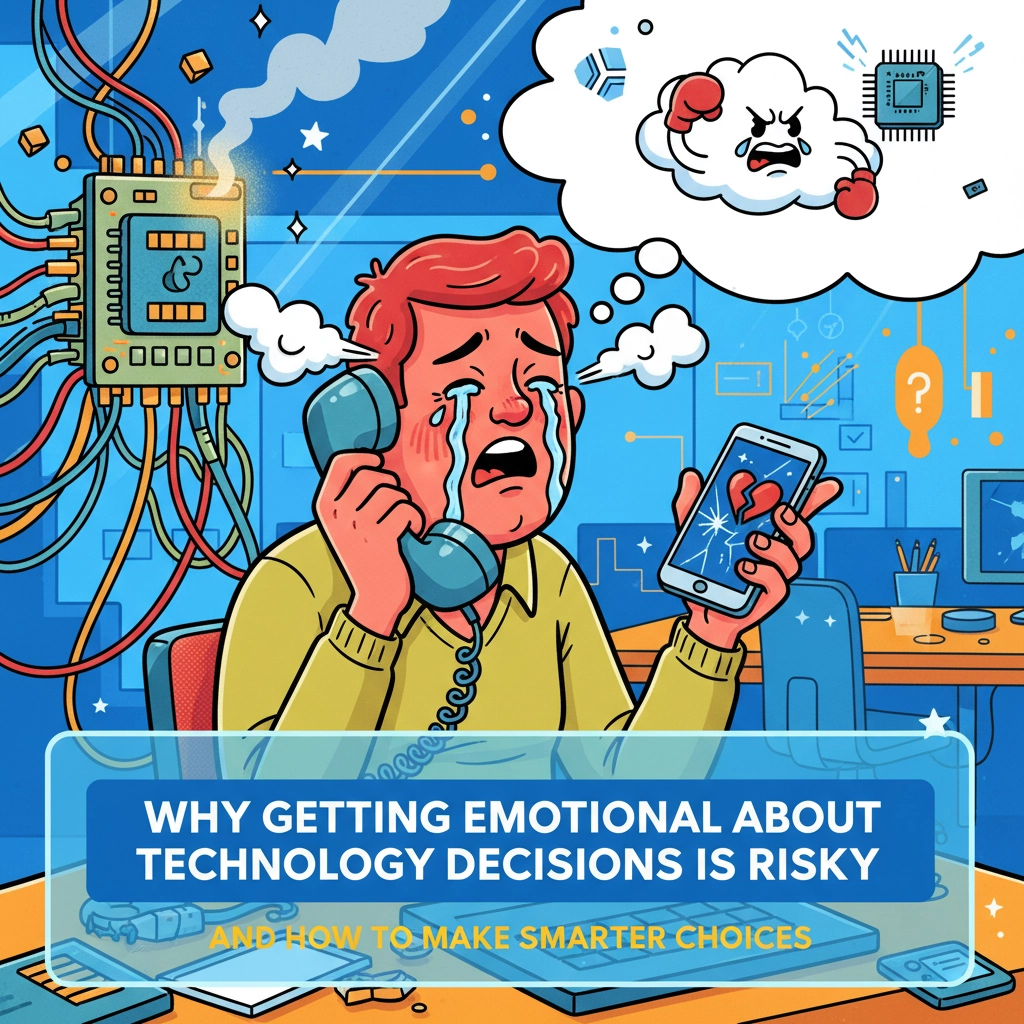Look, I get it. AI tools like ChatGPT are everywhere, and they’re pretty damn impressive. But here’s the thing that’s driving tech support providers (myself included) absolutely nuts: clients are using these tools to generate support requests that are making everything slower, more confusing, and way more frustrating than it needs to be.
If you’ve been copy-pasting AI-generated requests into your support tickets, this one’s for you. Let’s talk about why this well-intentioned approach is backfiring and what actually works instead.
The AI Fluff Problem: When More Words Mean Less Clarity
Here’s a scenario that happens way too often: A client needs help with their email setup. Instead of saying “My Outlook isn’t receiving emails,” they send us a beautifully crafted, 300-word dissertation about “optimizing email configuration parameters for enhanced communication efficacy” with flowery language that would make a corporate buzzword generator jealous.
The problem? I have to spend 10 minutes decoding what should have been a 30-second request. That AI-polished request that took you 5 minutes to generate and edit just cost us both way more time than a simple, direct message would have.
AI tools love to add unnecessary context, formal language, and technical-sounding jargon that doesn’t actually help solve your problem. When you ask ChatGPT to “make this sound professional,” it often translates “my thing is broken” into a paragraph that sounds impressive but tells us nothing useful about what’s actually wrong.

The “GPT Says It’s Possible” Trap
This one’s even worse. Clients come to us with requests for solutions that ChatGPT confidently told them were totally doable. Except they’re not. At all.
I’ve had clients ask for things like:
- “Setting up a blockchain-based backup system for their three-person dental office”
- “Implementing AI-powered network security that reads employee emotions”
- “Creating a custom CRM that automatically predicts customer behavior with 99% accuracy”
ChatGPT will happily explain how these things work in theory, complete with step-by-step instructions that sound completely legitimate. But here’s the reality check: just because an AI can describe something doesn’t mean it exists, works the way described, or makes sense for your situation.
We end up spending hours explaining why the AI’s suggestion won’t work, researching alternatives, and managing expectations that shouldn’t have been set in the first place. Meanwhile, your actual problem: the one that prompted you to ask the AI in the first place: still isn’t solved.
The Iteration Nightmare
Here’s where things get really frustrating. A client will send an AI-generated request for something that’s either impossible or unnecessarily complicated. We hop on a call to figure out what they actually need, spend an hour going in circles, and finally identify the real issue.
But instead of moving forward with the solution, they take our feedback back to ChatGPT to generate a “revised” request. Then we get another formal, AI-polished message that’s still missing the mark, just in a different way.
This back-and-forth can go on for days. What should have been a 20-minute conversation turns into multiple calls, endless email chains, and everyone getting more frustrated by the minute. The client thinks they’re being thorough and professional. We’re thinking “just tell us what’s broken in plain English.”
Why Provider Expertise Beats AI Confidence
Look, AI tools are impressive, but they don’t know your specific setup, your budget constraints, your technical limitations, or what actually makes sense for your business. They also can’t troubleshoot in real-time, adapt to unexpected findings, or apply years of hands-on experience to your unique situation.
When ChatGPT tells you something is possible, it’s pulling from training data that includes everything from theoretical research papers to random forum posts. It can’t distinguish between a lab experiment from 2018 and a proven solution that actually works in the real world today.
Your IT provider, on the other hand, has actually implemented solutions, dealt with the gotchas, and knows what works reliably. When we tell you something isn’t a good fit for your situation, it’s not because we’re being difficult: it’s because we’ve seen what happens when theoretical solutions meet real-world constraints.

What Actually Works: The Art of Clear Communication
Ready for the good news? Communicating effectively with your tech support is actually way easier than you think. Here’s what gets results:
Start with the problem, not the solution. Instead of asking us to implement ChatGPT’s elaborate fix, tell us what’s not working. “My email keeps bouncing back” is infinitely more helpful than a paragraph about “configuring SMTP authentication protocols for optimal delivery assurance.”
Skip the formalities. You don’t need to sound like a technical manual. “The thing is doing that weird thing again” is perfectly fine if you add a few specifics about what “weird thing” means.
Be specific about what you tried. “I restarted it and it’s still broken” tells us more than “I have undertaken preliminary troubleshooting measures as recommended by industry best practices.”
Include context that actually matters. When did this start? What changed? What error messages do you see? This is the stuff that helps us solve problems quickly.
The 20-Minute Rule
Here’s a reality check that might save your sanity: most tech issues can be explained clearly in under 20 minutes of back-and-forth communication. If you’re spending longer than that crafting the perfect AI-assisted request, you’re probably overcomplicating things.
Instead of multiple iterations of AI-polished requests, try this: spend 5 minutes writing down what’s wrong in your own words, then send it. We’d rather have a rough, human description of the actual problem than a polished description of what you think the solution should be.
When AI Actually Helps
Don’t get me wrong: AI isn’t all bad for tech support. It can be genuinely helpful for:
- Research and learning: Understanding technical concepts before you talk to your provider
- Documentation: Organizing information about your systems and issues
- Translation: Converting technical jargon into plain English (in the opposite direction of what most people are doing)
The key is using AI as a tool to understand your situation better, not as a middleman between you and your support team.
The Bottom Line
Your tech support provider wants to help you efficiently and effectively. We’re not judging your technical knowledge or expecting you to sound like a computer science textbook. We just need to understand what’s wrong so we can fix it.
The fastest path from “something’s broken” to “everything’s working” isn’t through an AI that’s trying to make you sound smarter. It’s through clear, honest communication about what you’re experiencing and what you need.
At Your Personal Ninja, we’ve found that the clients who get the best, fastest support are the ones who trust us enough to just tell us what’s going on without the AI-generated elaborate explanations. Try it: you might be surprised how much faster things move when everyone’s speaking the same language.
Save the AI-assisted communication for your marketing emails. For tech support, keep it human, keep it real, and keep it simple.
Share this:
- Click to share on Facebook (Opens in new window) Facebook
- Click to share on Tumblr (Opens in new window) Tumblr
- Click to share on X (Opens in new window) X
- Click to share on Pocket (Opens in new window) Pocket
- Click to share on Pinterest (Opens in new window) Pinterest
- Click to share on LinkedIn (Opens in new window) LinkedIn



